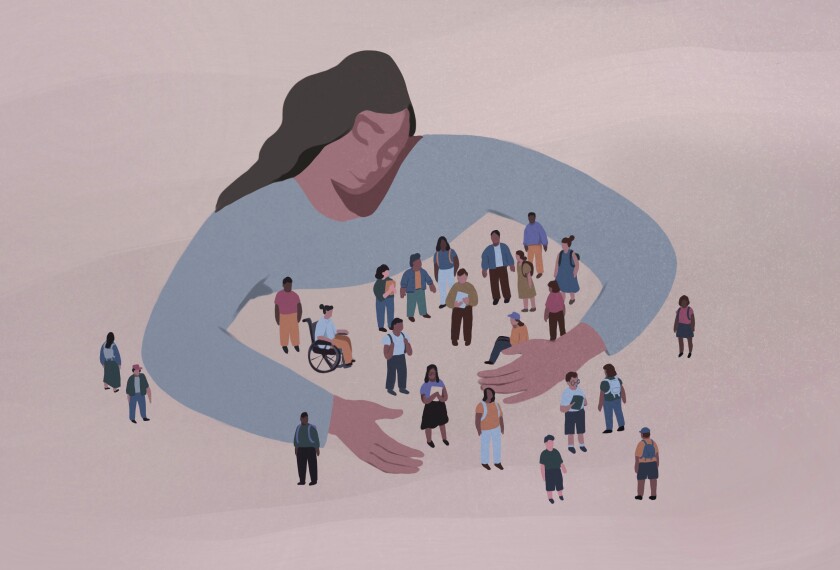Starting the formal path to teaching in high school may deepen the pool of new teachers and fight the public perception of teaching as a poor financial choice for a career, new research suggests.
Programs to recruit and train teachers locally, called “grow your own” models, have expanded rapidly in the last decade, spurred in part by teacher shortages, the greying of the existing workforce, and new financial support from states and federal pandemic relief grants. In a 2022 interview with Education Week, U.S. Secretary of Education Miguel Cardona voiced particular support for the programs.
As of 2022, more than 900 school districts and 200 higher education institutions operated some kind of grow-your-own program, recruiting and training teachers from the local community. But grow-your-own programs vary significantly around the country. They can range in recruiting focus from high school to college students to paraprofessionals and other workers, in models ranging from mentoring to full curriculum pathways like those used in South Carolina’s Teacher Cadets or Educators Rising, a nonprofit division of Phi Delta Kappa, International that provides curriculum and microcredentials for high school teacher-education programs.
A new study finds promise in one of the largest of these state grow-your-own programs, the Teacher Academy of Maryland, which creates a formal career-technical education pathway for high school students interested in going into teaching. A new working paper finds the Teacher Academy of Maryland widened the pipeline of students choosing to teach, as well as increased graduation rates, and boosted the pay of those in the teacher-academy program once they reached the classroom.
The Teacher Academy of Maryland, operating in school districts with support from the state, provides a four-class teaching sequence, with student-teaching practice and the opportunity for dual high school and college credit.
David Blazar, an associate professor of education policy at the University of Maryland, College Park and co-author of the study, tracked students’ participation and completion of the program, as well as their high school graduation rates, choice of field, and whether they ultimately entered the teaching profession.
Statewide, the researchers found that students who participated in one of the teaching academies were 0.6 percentage points more likely to choose a teaching career after high school. That’s a seemingly small amount, but with so few students entering teaching overall, it marks a jump of 47 percent. Overall, teacher-academy students also had higher high school graduation rates, and made 5 percent more per quarter once they entered the classroom than those who did not attend academies.
Closing teaching pipeline gaps
As in the teaching field overall, female students formed the overwhelming majority of the teaching academies statewide, and the program did not significantly improve the pipeline of young men entering the teaching field.
However, the Teacher Academy of Maryland did close the gap between young white and Black women becoming teachers. Among students who did not participate in the teacher academy, four times as many white girls became teachers after high school as Black girls (3.6 percent versus 0.9 percent). Among teaching academy students, the racial gap was only threefold between white and Black girls, with 5 percent of white girls and 1.6 percent of Black girls teaching after high school. Black girls participating in a teaching academy were 80 percent more likely to become teachers after high school.
“On first hearing, we might think the program’s solely going to benefit white females, but we find that’s not the case,” Blazar said. “Black females benefit pretty substantially from the program.”
Once they entered the workforce, Black teachers who had gone through the Maryland academies earned on average more than $640 more per quarter, or 18 percent of their quarterly wage, than Black teachers who had not participated.
Based on Maryland’s experience, districts like Baltimore County public schools have moved to expand their teacher academies to every high school.
Blazar recommended that district leaders interested in creating a local teacher education pathway:
- Plan ways to recruit and support young men, students of color, and students interested in high-need areas such as science, technology, engineering, and math. “We need to give a lot of thought to who is taking part in the program,” he said, “and tweak the design and professional development for teachers in ways to support recruitment” of men and teachers of color.
- Include a clear course sequence, such as learning theory and development.
- Give students practical experience in classrooms—such as via district early-childhood centers or tutoring—with mentorship. “Maryland is a pretty intensive, high-touch program,” Blazar said, “and I would imagine that that plays into its success.”
- Help students and their families think about financial planning for higher education and licensing costs after high school.
That financial and college-planning guidance may be particularly important, as Blazar said it could be one of the key barriers to teacher academy recruitment.
“My read is that recruitment is both not particularly systematic and also challenging,” he said. “I hear a lot that students and their parents are pretty wary of kids wanting to pursue a teaching career … due to big concerns that teaching is not going to be a financially viable career. … That is a lot of what schools and teachers are facing.”
The study found white girls were more likely to complete all four courses and pass the final teacher-licensing exam than were Black girls. White girls are also more likely to earn college credits than their Black peers. This indicates that white girls in the teaching academy were more likely to go on to receive a bachelor’s degree in education, while the vast majority of Black girls in the academy later entered the classroom through alternative certification.






